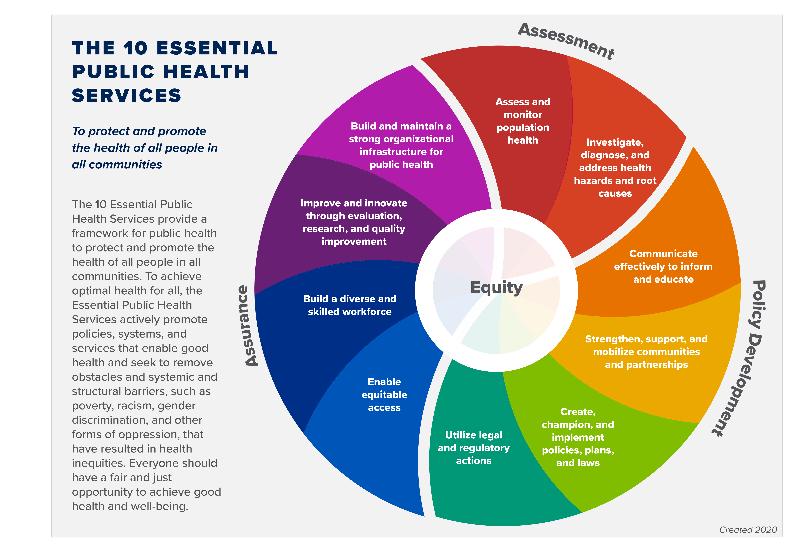10 Essential Public Health Services Review
Let's revisit the 10 essential public health services to see how each one was an integral component of this outbreak investigation.

Think about all of the different partners and agencies that were involved in this outbreak. It involved government agencies at all levels, medical providers, laboratories, and private organizations.
View the tabbed activity to relate specific actions by the LBOH to the core functions and EPHS.
MDPH has established a secure web-based surveillance and case management system for infectious diseases that enables rapid, efficient communication among local and state health departments and laboratories.
- It is called MAVEN, the Massachusetts Virtual Epidemiologic Network
Once the cases were reported to DBOH, an investigation was initiated and case reports were completed.
- The surveillance efforts by MDPH, CDC, and the DBOH linked the disease to pool exposure at the country club
To control further spread of the disease, an important public health response was a community wide hand-washing campaign, initiated by DBOH.
- It involved direct outreach to day care centers, schools, churches, and restaurants as well as print and cable TV announcements
The DBOH engaged the assistance of MDPH, CDC, the community hospital, local pediatricians, the public and private school communities, and the local day care centers to coordinate efforts to study and control the outbreak.
- The DBOH and its Medical Director also met with country club managers and members who were concerned about the cause and spread of this disease
- MDPH and CDC developed a survey tool for all country club members and club management agreed to send a letter with the survey to all members
- The survey results contributed greatly to MDPH and CDC analysis
To control further spread of the disease and to prevent future outbreaks, DBOH held hearings with country club managers and required action by the club, including the development of a corrective action plan with new policies and pool signage.
- DBOH routinely enforced the state sanitary codes for retail food establishments and swimming pools
- Using code provisions, DBOH inspected the country club facilities and conducted enforcement actions to gain compliance with the codes
The DBOH, primarily the Public Health Nurse, linked patients to the local hospital laboratory, which agreed to serve as a repository for fecal samples.
- The public health nurse also served as a referral source for any needed medical care and testing
In order to have an effective surveillance system for disease control and prevention, the public health workforce must be competent.
- The DBOH staff were trained, certified (e.g., RS, REHS, RN), and competent
- Their roles were further enhanced by collaboration with the medical community, MDPH, and CDC
While the outbreak was successfully controlled and plans and policies were established to prevent future outbreaks, DBOH recognized the need to improve on risk communication (not having plans or protocols in place at the time of the outbreak).
- DBOH sent staff to an appropriate training so the board could adopt a written communication plan
This outbreak of Giardia was fully investigated and a research report was published in Epidemiology & Infection. As the report notes in the Discussion section: "This outbreak illustrates the potential for enteric pathogens with low infectious doses to spread through person-to-person transmission following the introduction of the pathogen into a community through a point-source or common-source outbreak involving water, food or other appropriate source. Outbreaks involving multiple modes of transmission have been reported for Shigella and Cryptosporidium. This investigation demonstrates a similar capacity for Giardia; the potential for such multi-mode spread may also exist for pathogens such as norovirus and hepatitis A virus."
Now complete a knowledge check.